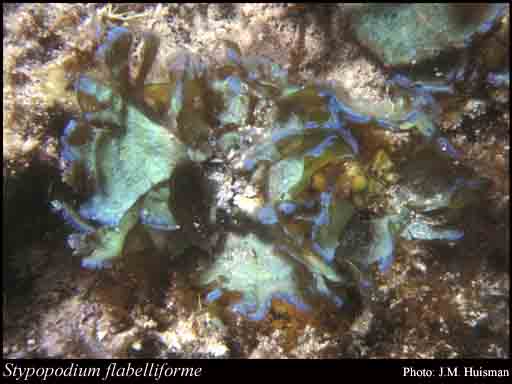- Reference
- Liste Alg.Siboga 1:176-178, Pl. II: Fig. 10, Pl. III: Fig. 2 (1913)
- Conservation Code
- Not threatened
- Naturalised Status
- Native to Western Australia
- Name Status
- Current

Scientific Description
Habit and structure. Thallus flabellate, partially decumbent, attached to the substratum by a broad holdfast, light brown, but often with a blue-green iridescence when viewed underwater, to 4–9 cm long and 2–9 cm wide. Axes 4–8 cells and 130–500 μm thick, with a cortical cell layer overlying larger rectangular medullary cells that are regularly to irregularly aligned in the upper to lower thallus, respectively. Reproductive structures not seen.
Distribution. Widespread in the warmer waters of the Indo-Pacific region. In Australia, known from Busselton, W.A., around northern Australia to Lord Howe Island and Jervis Bay, N.S.W.
Habitat. Epilithic in the intertidal and subtidal.
[After Huisman & Phillips, Algae of Australia: Mar. Benthic Algae of North-western Australia, 1. Green and Brown Algae 233 (2015)]
Distribution
- IBRA Regions
- Carnarvon, Dampierland, Geraldton Sandplains.
- IBRA Subregions
- Cape Range, Geraldton Hills, Pindanland.
- IMCRA Regions
- Abrolhos Islands, Kimberley, Ningaloo, Pilbara (nearshore), Pilbara (offshore), Shark Bay.
- Local Government Areas (LGAs)
- Ashburton, Broome, Exmouth, Greater Geraldton, Karratha, Shark Bay.